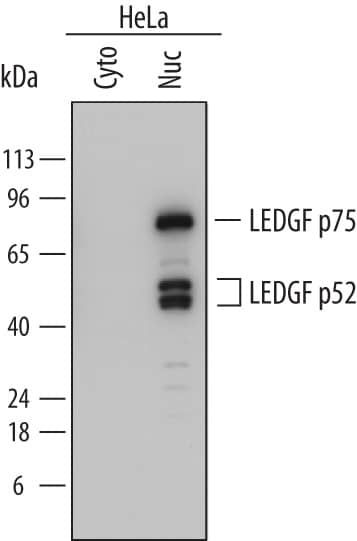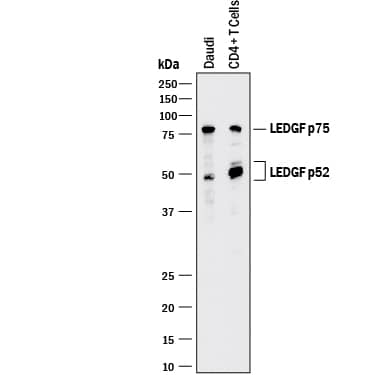LEDGF Products
Lens epithelium-derived growth factor (LEDGF; also PC4 and SFRS1-interacting protein, transcriptional coactivator p75/p53, and dense fine speckles 70 kDa protein) is a ubiquitously expressed, 75 kDa member of the hepatoma-derived growth factor (HDGF) family of proteins. Human LEDGF is 530 amino acids (aa) in length. LEDGF contains a PWWP domain (aa 1-64), a nuclear localization signal (aa 146-156), two coiled-coil regions (aa 306-334 and 371-395), and four helical regions (aa 347-362, 370-381, 394-403, and 410-425). In addition, there are multiple serine and threonine residues that are sites of potential phosphorylation. The protein is highly charged, with lysine, arginine, glutamate, and aspartate comprising 39% of the total residues. Two splicing variants produce a second isoform known as p53. p53 has an 8 aa substitution corresponding to aa 326-333 of LEDGF, and a deletion of the final 197 aa found in LEDGF. Human LEDGF shares 92% aa sequence identity with mouse and rat LEDGF. LEDGF functions as a transcriptional coactivator that is involved in neuroepithelial stem cell differentiation and neurogenesis. It is also a survival factor that is inducible by oxidative stress and protects cells from various stresses by upregulating stress-response genes. For example, TNF-alpha elevates the expression of LEDGF, which increases the expression of endogenous gamma-GHS-HS, a catalytic subunit of the regulating enzyme for GSH biosynthesis that constitutes a protective mechanism in limiting oxidative stress induced by inflammatory cytokines. LEDGF is also a major autoantigen in atopic dermatitis and other inflammatory conditions involving dysregulated apoptosis. Anti-LEDGF autoantibodies have been shown to have cytotoxic activity, suggesting their involvement in pathogenesis. In apoptotic cells, caspases cleave this protein at three sites within functionally important domains, abolishing the survival function of LEDGF and generating variants of the protein that enhance apoptosis. LEDGF has also been shown to interact with lentiviral integrase (IN) proteins, including HIV-1 IN, which determine their nuclear localization and tight association with nuclear DNA. This prevents proteosomal degradation of these proteins.
38 results for "LEDGF" in Products
38 results for "LEDGF" in Products
LEDGF Products
Lens epithelium-derived growth factor (LEDGF; also PC4 and SFRS1-interacting protein, transcriptional coactivator p75/p53, and dense fine speckles 70 kDa protein) is a ubiquitously expressed, 75 kDa member of the hepatoma-derived growth factor (HDGF) family of proteins. Human LEDGF is 530 amino acids (aa) in length. LEDGF contains a PWWP domain (aa 1-64), a nuclear localization signal (aa 146-156), two coiled-coil regions (aa 306-334 and 371-395), and four helical regions (aa 347-362, 370-381, 394-403, and 410-425). In addition, there are multiple serine and threonine residues that are sites of potential phosphorylation. The protein is highly charged, with lysine, arginine, glutamate, and aspartate comprising 39% of the total residues. Two splicing variants produce a second isoform known as p53. p53 has an 8 aa substitution corresponding to aa 326-333 of LEDGF, and a deletion of the final 197 aa found in LEDGF. Human LEDGF shares 92% aa sequence identity with mouse and rat LEDGF. LEDGF functions as a transcriptional coactivator that is involved in neuroepithelial stem cell differentiation and neurogenesis. It is also a survival factor that is inducible by oxidative stress and protects cells from various stresses by upregulating stress-response genes. For example, TNF-alpha elevates the expression of LEDGF, which increases the expression of endogenous gamma-GHS-HS, a catalytic subunit of the regulating enzyme for GSH biosynthesis that constitutes a protective mechanism in limiting oxidative stress induced by inflammatory cytokines. LEDGF is also a major autoantigen in atopic dermatitis and other inflammatory conditions involving dysregulated apoptosis. Anti-LEDGF autoantibodies have been shown to have cytotoxic activity, suggesting their involvement in pathogenesis. In apoptotic cells, caspases cleave this protein at three sites within functionally important domains, abolishing the survival function of LEDGF and generating variants of the protein that enhance apoptosis. LEDGF has also been shown to interact with lentiviral integrase (IN) proteins, including HIV-1 IN, which determine their nuclear localization and tight association with nuclear DNA. This prevents proteosomal degradation of these proteins.
| Source: | E. coli |
| Accession #: | NP_066967 |
| Applications: | BA |
| Reactivity: | Human |
| Details: | Mouse IgG1 Monoclonal Clone #762815 |
| Applications: | WB, ICC |
| Reactivity: | Human |
| Details: | Goat IgG Polyclonal |
| Applications: | WB, Simple Western, ICC, KO |
| Reactivity: | Human |
| Details: | Rabbit IgG Polyclonal |
| Applications: | WB, IP |
| Reactivity: | Human, Mouse |
| Details: | Rabbit IgG Polyclonal |
| Applications: | IHC, IP, WB (-) |
| Source: | E. coli |
| Accession #: | NP_150091 |
| Applications: | BA |
Recombinant Monoclonal Antibody
| Reactivity: | Human, Mouse, Rat |
| Details: | Rabbit IgG Monoclonal Clone #PSH02-55 |
| Applications: | IHC, WB, ICC/IF |
Recombinant Monoclonal Antibody
| Reactivity: | Human, Mouse, Rat |
| Details: | Rabbit IgG Monoclonal Clone #JE75-02 |
| Applications: | IHC, WB |
Recombinant Monoclonal Antibody
| Reactivity: | Human |
| Details: | Rabbit IgG Monoclonal Clone #SR2191 |
| Applications: | IHC, WB, ICC/IF |
| Reactivity: | Human, Mouse |
| Details: | Mouse IgG1 kappa Monoclonal Clone #3H1 |
| Applications: | IHC, WB, ELISA |
| Reactivity: | Human |
| Details: | Rabbit IgG Polyclonal |
| Applications: | IHC, ICC/IF |
| Reactivity: | Human |
| Details: | Mouse IgG1 kappa Monoclonal Clone #1C4 |
| Applications: | WB, ELISA, ICC/IF |
| Reactivity: | Human, Mouse |
| Details: | Rabbit IgG Polyclonal |
| Applications: | IHC, IP, WB (-) |
| Reactivity: | Human, Mouse |
| Details: | Rabbit IgG Polyclonal |
| Applications: | IHC, IP, WB (-) |
| Reactivity: | Human, Mouse |
| Details: | Rabbit IgG Polyclonal |
| Applications: | IHC, IP, WB (-) |
| Reactivity: | Human, Mouse |
| Details: | Rabbit IgG Polyclonal |
| Applications: | IHC, IP |
| Reactivity: | Human, Mouse |
| Details: | Rabbit IgG Polyclonal |
| Applications: | IHC, IP |
| Reactivity: | Human, Mouse |
| Details: | Rabbit IgG Polyclonal |
| Applications: | IHC, IP |
| Reactivity: | Human, Mouse |
| Details: | Rabbit IgG Polyclonal |
| Applications: | IHC, WB, IP |
| Reactivity: | Human, Mouse |
| Details: | Rabbit IgG Polyclonal |
| Applications: | IHC, IP |
| Reactivity: | Human, Mouse |
| Details: | Rabbit IgG Polyclonal |
| Applications: | IHC, WB, IP |
| Reactivity: | Human, Mouse |
| Details: | Rabbit IgG Polyclonal |
| Applications: | IHC, IP |
| Reactivity: | Human, Mouse |
| Details: | Rabbit IgG Polyclonal |
| Applications: | IHC, WB, IP |
| Reactivity: | Human, Mouse |
| Details: | Rabbit IgG Polyclonal |
| Applications: | IHC, WB, IP |
| Reactivity: | Human, Mouse |
| Details: | Rabbit IgG Polyclonal |
| Applications: | IHC, IP, WB (-) |





![Western Blot: LEDGF Antibody [NB110-40561] Western Blot: LEDGF Antibody [NB110-40561]](https://resources.bio-techne.com/images/products/LEDGF-Antibody-Western-Blot-NB110-40561-img0002.jpg)
![Immunohistochemistry-Paraffin: LEDGF Antibody [NB110-40560] Immunohistochemistry-Paraffin: LEDGF Antibody [NB110-40560]](https://resources.bio-techne.com/images/products/LEDGF-Antibody-Immunohistochemistry-Paraffin-NB110-40560-img0005.jpg)
![Western Blot: LEDGF Antibody (PSH02-55) [NBP3-32860] LEDGF Antibody (PSH02-55)](https://resources.bio-techne.com/images/products/nbp3-32860_rabbit-ledgf-mab-psh02-55-288202412442993.jpg)
![Western Blot: LEDGF Antibody (JE75-02) [NBP3-32859] LEDGF Antibody (JE75-02)](https://resources.bio-techne.com/images/products/nbp3-32859_rabbit-ledgf-mab-je75-02-288202412461663.jpg)
![Western Blot: LEDGF Antibody (SR2191) [NBP3-22622] -](https://resources.bio-techne.com/images/products/nbp3-22622_rabbit-ledgf-mab-sr2191-5720231624742.jpg)
![Western Blot: LEDGF Antibody (3H1) [H00011168-M01] Western Blot: LEDGF Antibody (3H1) [H00011168-M01]](https://resources.bio-techne.com/images/products/LEDGF-Antibody-3H1-Western-Blot-H00011168-M01-img0007.jpg)
![Immunocytochemistry/ Immunofluorescence: LEDGF Antibody [NBP1-87885] Immunocytochemistry/ Immunofluorescence: LEDGF Antibody [NBP1-87885]](https://resources.bio-techne.com/images/products/LEDGF-Antibody-Immunocytochemistry-Immunofluorescence-NBP1-87885-img0008.jpg)
![Western Blot: LEDGF Antibody (1C4) [H00011168-M02] Western Blot: LEDGF Antibody (1C4) [H00011168-M02]](https://resources.bio-techne.com/images/products/LEDGF-Antibody-1C4-Western-Blot-H00011168-M02-img0006.jpg)
